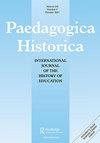教育疗法还是特殊儿童的信息交换所?洛杉矶调节性房间的发展,1916-1923
IF 0.3
4区 教育学
Q4 EDUCATION & EDUCATIONAL RESEARCH
引用次数: 0
摘要
摘要:本研究探讨了二十世纪初在洛杉矶公立学校特殊教育班设立“调适室”的目的和实践。与调整室有关的设立和做法是与学童分类和分流有关的更广泛的国际趋势的一个当地例子。在本研究中,我认为分类功能和规范化结构嵌入到调整室的实践中。由于洛杉矶有一群不同的儿童被安置在未分级的房间里,没有得到适当的教育,因此调整房间的做法是通过从其中确定可受教育的儿童来开始的。因此,在当时进步主义教育界备受关注的新教育方法应运而生,以弥补教育上的滞后。调整室的目的是为了教育“落后”和“不适应”的孩子,提供辅助教育,并在短时间内让他们回到正常的班级。因此,一方面,调适室具有促进向标准学生模式规范化的功能。另一方面,调整室作为一个“交换所”,对儿童进行分类,根据模糊的教育潜力标准决定他们的命运。虽然曾试图将可接受教育的落后和不适应环境的儿童送回正规班级,但“弱智”儿童被判定为无法接受教育,并被排除在调整室周期之外,从而促进了学校内部的排斥。本文章由计算机程序翻译,如有差异,请以英文原文为准。
Educational therapeutics or a clearing house for exceptional children?: the development of adjustment rooms in Los Angeles, 1916–1923
ABSTRACT This study examines the purpose and practice of “adjustment rooms” established in special education classes in Los Angeles public schools in the early twentieth century. The establishment and practices associated with adjustment rooms are a local example of broader international trends related to the classification and streaming of schoolchildren. In this study, I argue that the function of classification and the structure of normalisation were embedded in the practices of adjustment rooms. Since a diverse group of children were being placed in ungraded rooms in Los Angeles and were not being properly educated, the adjustment room practice was initiated by identifying educable children from among them. New educational methods, which were gaining attention in progressive education at the time, were thus developed to compensate for educational delays. The goal of the adjustment rooms, which were designed to educate “backward” and “misfit” children, was to provide auxiliary education and return them to regular classes in a short period of time. Thus, on the one hand, the adjustment room had the function of promoting normalisation to the standard student model. On the other hand, the adjustment room functioned as a “clearing house” to categorise children, deciding their fate according to ambiguous criteria of educational potential. While attempts were made to return educable backward and misfit children to regular classes, “feeble-minded” children were judged to be uneducable and were removed from the adjustment room cycle, thereby promoting internal exclusion within schools.
求助全文
通过发布文献求助,成功后即可免费获取论文全文。
去求助
来源期刊

PAEDAGOGICA HISTORICA
Multiple-
CiteScore
0.90
自引率
40.00%
发文量
72
期刊介绍:
"Paedagogica Historica is undoubtedly the leading journal in the field. In contrast to a series of national journals for the history of education, Paedagogica Historica is the most international one." A trilingual journal with European roots, Paedagogica Historica discusses global education issues from an historical perspective. Topics include: •Childhood and Youth •Comparative and International Education •Cultural and social policy •Curriculum •Education reform •Historiography •Schooling •Teachers •Textbooks •Theory and Methodology •The urban and rural school environment •Women and gender issues in Education
 求助内容:
求助内容: 应助结果提醒方式:
应助结果提醒方式:


